Introduction
This is the second part of a two-part article about the sidestroke. The first part covered the position of the body and the arm movements.
This part will cover the leg movements, the coordination between arms and legs and breathing.
Scissor Kick
The sidestroke uses a scissor kick where the legs move simultaneously but in different directions, a little bit like the blades of scissors.
Let’s imagine that you are in the initial position at the beginning of the stroke cycle:
- Your legs are extended.
- Your feet are pointed.

In the first non-propulsive phase of the scissor kick, your legs flex and move apart on a horizontal plane:
- Your top leg moves forward relative to your body. Your hip and knee bend simultaneously until both joints are bent slightly less than 45°. Your top foot just follows along.
- Your bottom leg moves in the opposite direction. It bends a little bit backward at the hip and a lot at the knee (more than 90°). In fact, it looks a little bit as if you were trying to touch your buttocks with your lower foot.
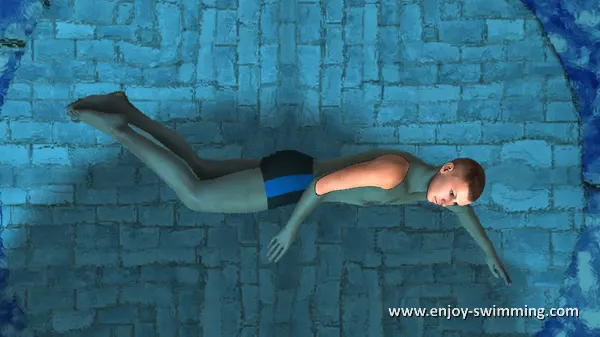
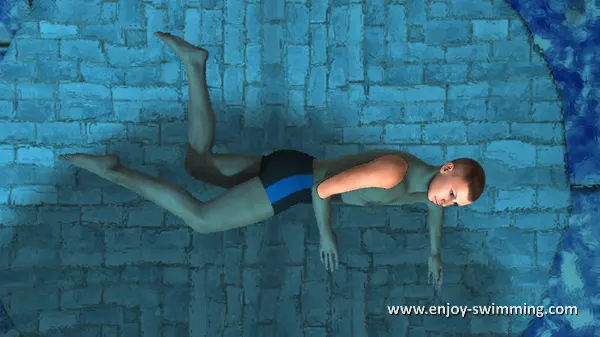
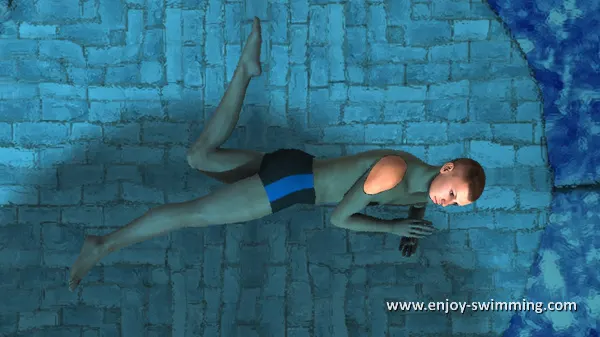
The second phase of the kick begins once your legs have reached their maximum flexion. Your legs then extend and create propulsion.
- Your top leg extends both at the hip and at the knee. Your foot is pointed so that you effectively push against the water with your calf and the sole of your foot.
- Your bottom leg also extends a little bit at the hip and much more at the knee. Your foot is also pointed, and you effectively push water backward with your shin and the top of your foot.
- Your legs continue to extend up to the point where they have moved back to their initial position.
- You can observe a short glide phase once your legs (and arms) are extended before you start the next stroke cycle.
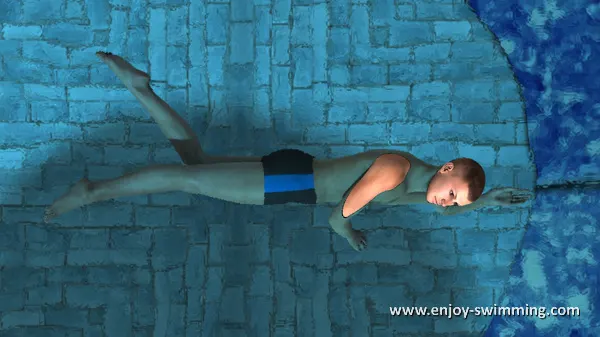
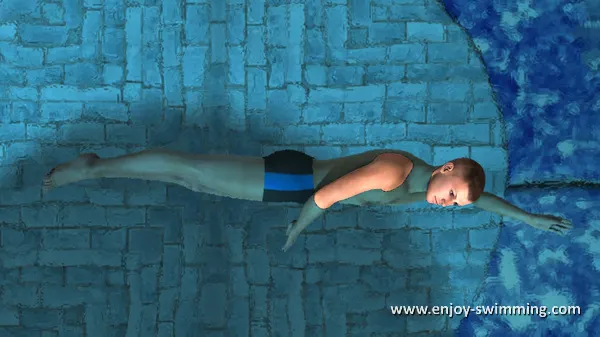
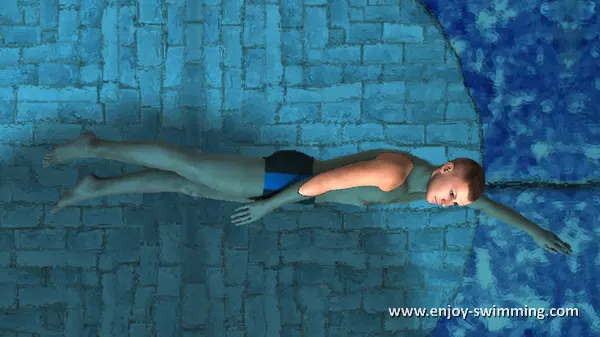
Coordination between Arms and Legs
In the beginning, the coordination of the arms and legs can be difficult because the sidestroke uses asymmetrical movements. Using the following cues can help:
- The top arm and top knee always move in the same direction at the same time. Forward (relative to your swimming direction) during flexion and backward during extension.
- Your arms and legs flex at the same time and also extend at the same time: In the initial position, both arms and both legs are extended. Afterward, your hands meet in front of your chest at the same time that your legs are at the maximum of their flexion.
Swimming Video
Here is a video that shows what swimming sidestroke looks like in real life:
Breathing
Inhaling: If you watch the video above closely, you can see that I inhale quickly at the end of the phase where the arms move apart and during the short glide phase that follows.
That’s because the propulsive action of the legs and the trailing arm causes the chest and head to rise slightly higher. Rolling the head a little bit upwards also helps for the mouth to clear the water.
Exhaling: You can pretty much exhale for the rest of the stroke cycle. I even exhale partly in the water as my mouth and nose are below the water surface at times.
You can also lift the lower side of your head above the water surface while swimming to make breathing easier, but this can strain your neck if done over long distances.
By the way, you don’t need to breathe every stroke cycle. You can exhale slowly and only breathe every second or third stroke cycle.
Learning the Sidestroke
We have a sequence of progressive exercises to learn the sidestroke here.
Advantages of the Sidestroke
The sidestroke has the following advantages and uses:
- Because the face is above the water surface all the time, you avoid breathing and visibility issues.
- You can use it for relaxed long-distance swimming. You can observe a longer glide phase at the end of each stroke cycle. And you can switch over to your other side once you become tired swimming on your current side.
- The sidestroke can be a welcome alternative from the more common swimming strokes because you tend to swim the latter ones all the time.
- It is also useful for lifeguards when rescuing victims. The lifeguard can hold the victim against his chest with one arm, and especially so if the victim has a rescue buoy to hold on to. The lifeguard can then still use his other arm and his legs for swimming.
Disadvantages of the Sidestroke
The sidestroke also has a few drawbacks:
- It can’t be used in competitions: it isn’t allowed in any event except in freestyle races, and in that event, it isn’t fast enough to compete with the front crawl stroke.
- Because your face is turned sideways, you don’t see in the direction you are swimming to. You need to twist your head a little bit to glance forward. Another solution is to switch sides every few strokes and take a quick glance forward while switching.
Related Pages
You may also be interested in the following articles that cover the sidestroke’s swimming technique:

Joy
Thursday 21st of September 2023
"Swimming Video Here is a video that shows what swimming sidestroke looks like in real life:"
No video! I tried two browsers.
Christophe
Friday 22nd of September 2023
Hi Joy,
This typically happens with browsers that block ads. The videos are hosted by the ad server.
All the best,
Christophe
Annette
Friday 25th of September 2020
Should you side stroke on both sides for muscle equality? I'm right-handed and feels more natural but I'm thinking I should do both sides
Chris
Monday 28th of September 2020
Hi Anette,
I think it is indeed better to alternate sides for muscular balance.